Connecting...

This is a quick preview of the lesson. For full access, please Log In or Sign up.
For more information, please see full course syllabus of Algebra 2
For more information, please see full course syllabus of Algebra 2
Algebra 2 Direct, Joint, and Inverse Variation
Lecture Description
The function varies directly as x if there is a non-zero constant k such that y=kx. The constant k is called the constant of variation. The graph of a direct variation is a straight line through the origin. Its slope is the constant k of variation. Joint variation is very similar to the direct variation, however, you’ll be working with three variables instead of two. The function varies inversely as x if there is a non-zero constant k such that y=k/x. The graph of an inverse variation is very similar to the graph of a rational function - it has asymptotes. This lecture also covers proportions, which can be used to solve problems involving different variations.
Bookmark & Share
Embed
Share this knowledge with your friends!
Copy & Paste this embed code into your website’s HTML
Please ensure that your website editor is in text mode when you paste the code.(In Wordpress, the mode button is on the top right corner.)
×
Since this lesson is not free, only the preview will appear on your website.
- - Allow users to view the embedded video in full-size.
Next Lecture
Previous Lecture









































 Carleen Eaton
Carleen Eaton Grant Fraser
Grant Fraser
 Answer Engine
Answer Engine



0 answers
Post by DJ Sai on September 16, 2018
The graph at 7:45 is not scaled properly